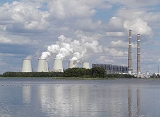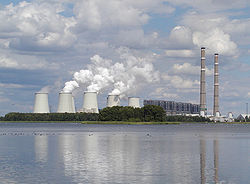
Power Station Jänschwalde
Encyclopedia

Jänschwalde
Jänschwalde is a municipality in the district of Spree-Neiße in Brandenburg in East Germany. It is situated in the region of Niederlausitz...
in Brandenburg
Brandenburg
Brandenburg is one of the sixteen federal-states of Germany. It lies in the east of the country and is one of the new federal states that were re-created in 1990 upon the reunification of the former West Germany and East Germany. The capital is Potsdam...
on the German
Germany
Germany , officially the Federal Republic of Germany , is a federal parliamentary republic in Europe. The country consists of 16 states while the capital and largest city is Berlin. Germany covers an area of 357,021 km2 and has a largely temperate seasonal climate...
-Polish
Poland
Poland , officially the Republic of Poland , is a country in Central Europe bordered by Germany to the west; the Czech Republic and Slovakia to the south; Ukraine, Belarus and Lithuania to the east; and the Baltic Sea and Kaliningrad Oblast, a Russian exclave, to the north...
border. The lignite
Lignite
Lignite, often referred to as brown coal, or Rosebud coal by Northern Pacific Railroad,is a soft brown fuel with characteristics that put it somewhere between coal and peat...
-fired power station
Power station
A power station is an industrial facility for the generation of electric energy....
has an installed capacity of 3,000 megawatts and consists of six 500 MW units. It is the second-largest brown coal power plant in operation in Germany and is owned by Swedish
Sweden
Sweden , officially the Kingdom of Sweden , is a Nordic country on the Scandinavian Peninsula in Northern Europe. Sweden borders with Norway and Finland and is connected to Denmark by a bridge-tunnel across the Öresund....
state-owned Vattenfall
Vattenfall
Vattenfall is a Swedish power company. The name Vattenfall is Swedish for waterfall, and is an abbreviation of its original name, Royal Waterfall Board...
.
The power station was built between 1976 and 1989. Between the German reunification
German reunification
German reunification was the process in 1990 in which the German Democratic Republic joined the Federal Republic of Germany , and when Berlin reunited into a single city, as provided by its then Grundgesetz constitution Article 23. The start of this process is commonly referred by Germans as die...
and the mid-1990s, modern environmental technology was adopted, making higher efficiency possible. Despite this, the power station has the fifth-lowest ratio of energy efficiency to CO2 emission in Europe, according to a study by the WWF
World Wide Fund for Nature
The World Wide Fund for Nature is an international non-governmental organization working on issues regarding the conservation, research and restoration of the environment, formerly named the World Wildlife Fund, which remains its official name in Canada and the United States...
.
Jänschwalde power station predominantly fires raw brown coal from nearby open-pit mining
Open-pit mining
Open-pit mining or opencast mining refers to a method of extracting rock or minerals from the earth by their removal from an open pit or borrow....
in Jänschwalde and Cottbus
Cottbus
Cottbus is a city in Brandenburg, Germany, situated around southeast of Berlin, on the River Spree. As of , its population was .- History :...
to the north. At full load the power station burns approximately 80,000 tons of brown coal a day. From one kilogram of brown coal about one kilowatt-hour of electrical energy is produced.
The yearly power output lies around 22 billion kWh, 22 TWh.
The site formerly featured three obsolete 300 metres (984.3 ft) chimneys. These were gradually dismantled in a complex process between 2002 and 2007, as conventional demolition was not possible on the site for space reasons. A unique procedure was introduced for this task: the chimneys were broken down from the top to a height of 50 metres (164 ft) by a special mechanism equipped with excavators which works round the edges of the chimneys, after which the remaining stacks are being demolished by conventional means.

